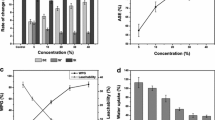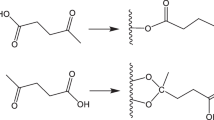Summary
In terms of the problem of formaldehyde-releasing, glyoxal is one of the interesting dialdehydes as a crosslinking agent for wood. In the present report, the reaction of glyoxal and glyoxal/glycol with the wood of Japanese ash (Fraxinus mandshurica Rupr. var. japonica Maxim.) has been studied. Particular attention to the structure of the product (after treatment with glyoxal/glycol (glycol: ethylene glycol, diethylene glycol, triethylene glycol)) was made and the formation of crosslinking has been discussed. Reaction of only glyoxal with wood showed little reactivity, while that of glyoxal/glycol gave high weight increases for each glycol. The appropriate condition was at 100° to 130°C for 2 hrs. It was found that the product forms network structures, at least within itself. The crosslinking between the product and wood components, however, could not be confirmed, although it was assumed that the product was structurally linked to wood by its reactive sites.
Similar content being viewed by others
References
Gonzales, E. J.; Guthrie, J. D. 1969: Crosslinking cotton cellulose with glyoxal reaction products. American Dyestuff Reporter. 58: 27–29
Harrington, K. J.; Higgins, H. G.; Michell, A. J. 1964: Infrared spectra of Eucalyptus regnans F. Muell and Pinus radiata D. Don. Holzforschung 18: 108–113
Head, F. S. H. 1958: The reactions of cellulose with glyoxal. J. Textile Inst. 49, T345–356
Ito, T. 1992: Dimensional stabilization of woods treated with the condensed-ring compounds made from glyoxal, urea and formaldehyde (glyoxal resins) I. Mokuzai Kogyo 47: 114–119
Michel, A. J.; Watson, A. J.; Higgins, H. G. 1965: An infrared spectroscopic study of delignification of Eucalyptus regnans. Tappi 48: 520–532
Weaver, J. W.; Nealson, J. F.; Goldstein, I. S. 1960: Dimensional stabilization of wood with aldehyde and related compounds. Forest Products J. 6: 306–310
Welch, C. M. 1983: Glyoxal as a formaldehyde-free durable press reagent for mild curing applications. Textile Res. J. 53: 181–186
Welch, C. M. 1984: Glyoxal-glycol mild cure process: formaldehyde-free durable press finishing of cotton. Textile Chem. Color. 16: 265–270
Welch, C. M.; Danna, G. F. 1982: Glyoxal as a non-nitrogenous formaldehyde-free durable-press reagent for cotton. Textile Res. J. 52: 149–157
Welch, C. M.; Peters, J. G. 1987: Low, medium, and high temperature catalysts for formaldehyde-free durable press finishing by the glyoxal-glycol process. Textile Res. J. 57: 351–356
Whipple, E. B. 1970: The structure of glyoxal in water. J. Am. Chem. Soc. 92: 7183–7186
Yamamoto, K. 1982: Crease-resistance treatment of cotton fabrics with non-formaldehyde crosslinking agents. Textile Res. J. 52: 357–365
Yasuda, R.; Minato, K.; Okamura, K. 1992: Improvement of dimensional stabilization and acoustic properties of wood with non-formaldehyde crosslinking agents. Abstracts of the 42nd Annual Meeting of Japan Wood Research Society: pp. 292
Author information
Authors and Affiliations
Rights and permissions
About this article
Cite this article
Nakano, T. Reaction of glyoxal and glyoxal/glycol with wood. Wood Sci.Technol. 28, 23–33 (1993). https://doi.org/10.1007/BF00193873
Received:
Issue Date:
DOI: https://doi.org/10.1007/BF00193873




